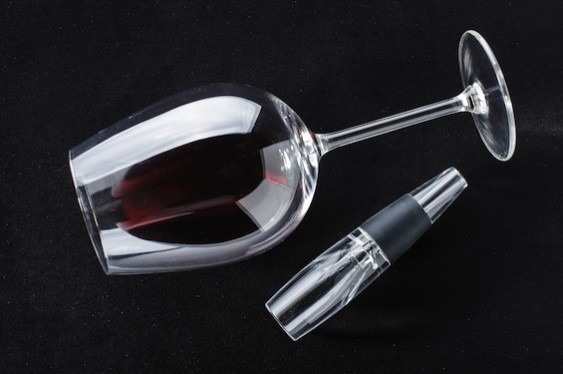Patience may be a virtue, especially when it comes to wine. But sometimes, when you’ve been hanging onto a great bottle and you finally decide to open it, you want to enjoy it as soon as possible. (That said, taking time to let a bottle breathe can provide useful time for other tasks like putting the finishing touches on a dinner dish, doing the New York Times crossword puzzle, or fitting in a little extra canoodling with your dinner date, so don’t rush things too much!)
For those times, you might want to consider getting a wine aerator. Basically, wine aerators are funnels you pour wine through that expose more of the liquid to oxygen faster. By doing so, wine aerators accomplish two things: oxidation and evaporation. Oxidation is the introduction of oxygen into the wine, while aeration is the transformation of liquids into gas (sorry for the remedial chemistry lesson here).

Aerators help…aerate your wine faster.
So what does each do? With oxidation, some of the tannins (which can be bitter to the taste) break down, allowing more subtle nuances and flavors to come to the foreground. With evaporation, alcohol particles are released, carrying aromas and other compounds into your nose so that you can actually smell those delicious nuances.
While letting oxygen into a wine that you hope to age can ruin it, getting a little bit into your wine before you drink it can be imperative – especially if you’re drinking a full-bodied red wine…or a slightly less than top-quality wine (no judgment). Luckily, the unpleasant or weird-smelling compounds like burny-smelly sulfites (which are added to wine to prevent oxidation and bacterial contamination) tend to evaporate off before the desirable ones. Ethanol, the alcohol compound in wine, also evaporates more quickly than wine’s other components, so that that rubbing-alcohol smell that can sometimes mask other flavors becomes fainter and a wine’s other notes become more evident.
Plus, rather than swirling an old wine in the decanter, or displacing sediments at the bottom of a bottle and ending up with goop in your glass, an aerator does the heavy lifting for you so that you can pour a wine gently, or even glass by glass, without worrying.

Aeration accomplishes many of the same things as decanting.
That said, you don’t need an aerator for most of your wine. Those moderately priced fruity, jammy powerhouse reds you keep in reserve for a quick fix don’t need it. And those crisp, white wines you’re probably enjoying on a summer evening won’t improve with aeration. But if you’ve been aging a bottle for a few years and waiting for the right moment to open it, you might consider using an aerator when you do. However, I’d suggest trying a little taste of the wine without the aerator and then trying a little taste that you’ve aerated. That way, before you send the whole bottle through the apparatus, you can determine if you think the taste has actually improved!
So should you get a wine aerator? Probably. Especially for those last-minute dinner parties where you don’t have time to let those bottles breathe…or just to play a fun taste-comparison drinking game with your friends.
But you don’t spend have to spend too much money on it, either. The biggest brand in the game is Vinturi, with a variety of aerators available (just go for the one-size-fits-all Essential Wine Aerator), which you should be able to pick up for $15-$30 at any number of retailers like Target, Amazon, Williams-Sonoma and Bed, Bath & Beyond. Happy pouring!

